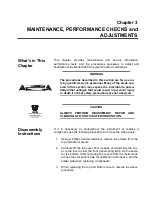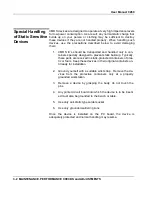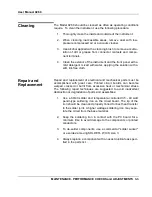
User Manual 9260
1-4 Portrayal
As explained above, all options must be specified at the time of
your purchase and the 9260 is supplied fully configured.
Reconfiguration of fielded instruments can be done by qualified and
trained persons only.
Specifications
Instrument specifications are listed in Appendix A. These
specifications are the performance standards or limits against
which the instrument is tested. Specifications apply under the
following conditions: output terminated into load impedance, after
30 minutes of warm up time, and within a temperature range of
20
C to 30
C. Specifications outside of the temperature range are
degraded by 0.1% per
C.
Front Panel
Connectors
The 9260 has 4 BNC connectors on its front panel, two for each
channel. Two are marked INPUT and the other two are marked
OUTPUT. These connectors are described below.
Channel 1 Input
The input connector accepts signals within the range of DC to over
35 MHz and amplifies them by a fixed gain. The gain is normally
x10 however, this number may be different if you ordered the
amplifier with different gain setting. Input impedance is factory pre-
conditioned and has one of the following values: 50
, or 1M
.
1M
input impedance can be used for low frequency signals (up to
100kHz) however, higher frequencies require 50
termination at
the input of the amplifier to eliminate standing waves and
reflections in the input cable, which can cause excessive ringing
and aberrations at the output.
The amplifier input cannot tolerate high voltage on its 50
resistance. Therefore, before applying the cable to the input
connector, make sure your signal will not exceed input rating, as
specified in Appendix A of this manual.
Note
Channel 1 Input only is used when the Model 9260
is configured to operate in differential mode.













































